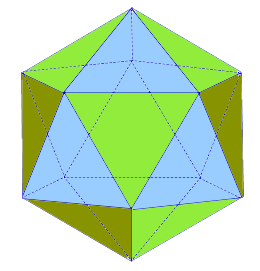Icosahedron Calculator
Online calculator and formulas to calculate an icosahedron
Icosahedron Calculator
The Regular Icosahedron
An icosahedron is a platonic solid with 20 triangular faces, 12 vertices, and 30 edges.
Platonic Solid Properties
The Water Element: Dual to the dodecahedron with pure triangular faces
Icosahedron Structure

20 equilateral triangles forming perfect symmetry.
Dual polyhedron to the dodecahedron.
|
|
What is an Icosahedron?
An icosahedron is one of the five platonic solids:
- Definition: 20 congruent equilateral triangles
- Platonic Solid: Perfect regular polyhedron
- Faces: 20 equilateral triangles
- Vertices: 12 corners
- Edges: 30 equal edges
- Dual: Dual polyhedron to dodecahedron
Geometric Properties of the Icosahedron
The icosahedron demonstrates remarkable triangular symmetry:
Basic Parameters
- Faces: 20 equilateral triangles
- Vertices: 12 corners (5 faces meet)
- Edges: 30 edges (all equal length)
- Euler characteristic: V - E + F = 12 - 30 + 20 = 2
Special Properties
- Deltahedron: All faces are triangles
- Golden ratio: All proportions involve φ
- Regular faces: All faces are equilateral triangles
- Dual polyhedron: Dual to the dodecahedron
Mathematical Relationships
The icosahedron embodies triangular perfection with golden ratio relationships:
Volume Formula
Formula involving φ. Golden ratio embedded.
Surface Formula
20 equilateral triangles. Simple √3 relationship.
Applications of the Icosahedron
Icosahedrons appear in nature and technology due to their optimal triangular structure:
Biology & Medicine
- Virus capsid structures (common shape)
- Protein folding patterns
- Cellular structures
- Drug delivery systems
Science & Technology
- Fullerene chemistry (C60 buckyball)
- Geodesic dome architecture
- Satellite structures
- Crystal mineralogy
Education & Mathematics
- Golden ratio demonstrations
- Triangular geometry studies
- Platonic solids theory
- Duality relationships
Games & Design
- 20-sided gaming dice (d20)
- Architectural geodesic domes
- Art installations and sculptures
- Puzzle and mechanical designs
Icosahedron Formulas
Volume (V)
Formula with golden ratio relationship through √5
Surface Area (S)
20 equilateral triangles: 20 × (√3/4)a² = 5√3a²
Circumradius (Rc)
Radius to vertices, involving golden ratio
Midradius (Rm)
Radius to edge midpoints = (a/4)(1+√5) = (a·φ)/2
Inradius (Ri)
Radius to face centers
Diagonal
Simple relationship to circumradius
Golden Ratio & Duality
\(\phi = \frac{1+\sqrt{5}}{2}\)
\(\frac{\sqrt{3}}{4}a^2\)
20 faces ↔ 20 vertices
Water (Plato)
The icosahedron and dodecahedron are dual polyhedra with golden ratio proportions
Calculation Example for an Icosahedron
Given
Find: All properties of the icosahedron
1. Volume Calculation
For a = 10:
\[V = \frac{5}{12} \times 10^3 \times (3+\sqrt{5})\] \[V = \frac{5000}{12} \times (3+2.236)\] \[V ≈ 416.67 \times 5.236 ≈ 2182\]The volume is approximately 2182 cubic units
2. Surface Area Calculation
For a = 10:
\[S = 5 \times 10^2 \times \sqrt{3}\] \[S = 500 \times 1.732\] \[S ≈ 866\]The surface area is approximately 866 square units
3. Circumradius Calculation
For a = 10:
\[R_c = \frac{10}{4} \sqrt{10 + 2\sqrt{5}}\] \[R_c = 2.5 \sqrt{10 + 4.472}\] \[R_c ≈ 2.5 \times 3.804 ≈ 9.51\]The circumradius is approximately 9.51 units
4. Midradius Calculation
For a = 10:
\[R_m = \frac{10}{4} (1 +\sqrt{5})\] \[R_m = 2.5 \times (1 + 2.236)\] \[R_m ≈ 2.5 \times 3.236 ≈ 8.09\]The midradius is approximately 8.09 units
5. Complete Icosahedron Properties
The icosahedron with perfect triangular symmetry and golden ratio relationships
The Icosahedron: Perfect Triangular Harmony
The icosahedron represents the pinnacle of triangular perfection among the Platonic solids, with its 20 equilateral triangular faces creating a sphere-like form of extraordinary symmetry. As the dual polyhedron to the dodecahedron, it demonstrates the profound mathematical relationship between pentagonal and triangular geometries, both unified by the golden ratio φ. Ancient Greeks associated the icosahedron with water, recognizing its fluid-like curved appearance despite being constructed entirely from flat triangular faces. Modern science has validated this intuition, as the icosahedral shape appears repeatedly in nature - from virus capsids to fullerene molecules - proving that this ancient geometric form represents one of nature's most efficient and stable structures.
The Geometry of Triangular Perfection
The icosahedron exemplifies the power of triangular construction:
- Deltahedron: All 20 faces are congruent equilateral triangles
- Icosahedral Symmetry: The highest possible rotational symmetry
- Golden Ratio: All measurements involve φ through √5 relationships
- Dual Polyhedron: Perfect duality with the dodecahedron (20↔12)
- Spherical Approximation: Closest approximation to a sphere
- Minimal Surface: Maximum volume for given surface area among polyhedra
- Natural Occurrence: Ubiquitous in biological and molecular structures
Mathematical Beauty
Triangular Excellence
As a deltahedron with 20 equilateral triangles, the icosahedron demonstrates how simple triangular elements can create complex, beautiful forms with perfect symmetry.
Golden Ratio Integration
Every formula contains √5, directly connecting to φ. The icosahedron is a 3D expression of the golden rectangle and pentagon relationships.
Dual Relationship
Its perfect duality with the dodecahedron (20 faces ↔ 20 vertices) reveals deep mathematical connections between triangular and pentagonal geometries.
Biological Significance
From virus capsids to buckyballs, the icosahedron appears when nature needs maximum stability and minimal energy configurations.
Summary
The icosahedron stands as nature's favorite polyhedron, combining mathematical elegance with practical efficiency. Its 20 triangular faces, unified by golden ratio relationships, create the most sphere-like regular polyhedron possible. From ancient Greek philosophy to modern virology, from fullerene chemistry to geodesic architecture, the icosahedron continues to demonstrate that triangular perfection is both mathematically beautiful and naturally optimal. As the dual to the dodecahedron, it completes the profound geometric relationship between the triangle and pentagon, showing how these two fundamental shapes are united through the golden ratio. The icosahedron reminds us that in both mathematics and nature, the simplest forms often yield the most complex and beautiful results.
|
|
|
|
Tetrahedron • Cube • Octahedron • Dodecahedron • Icosahedron